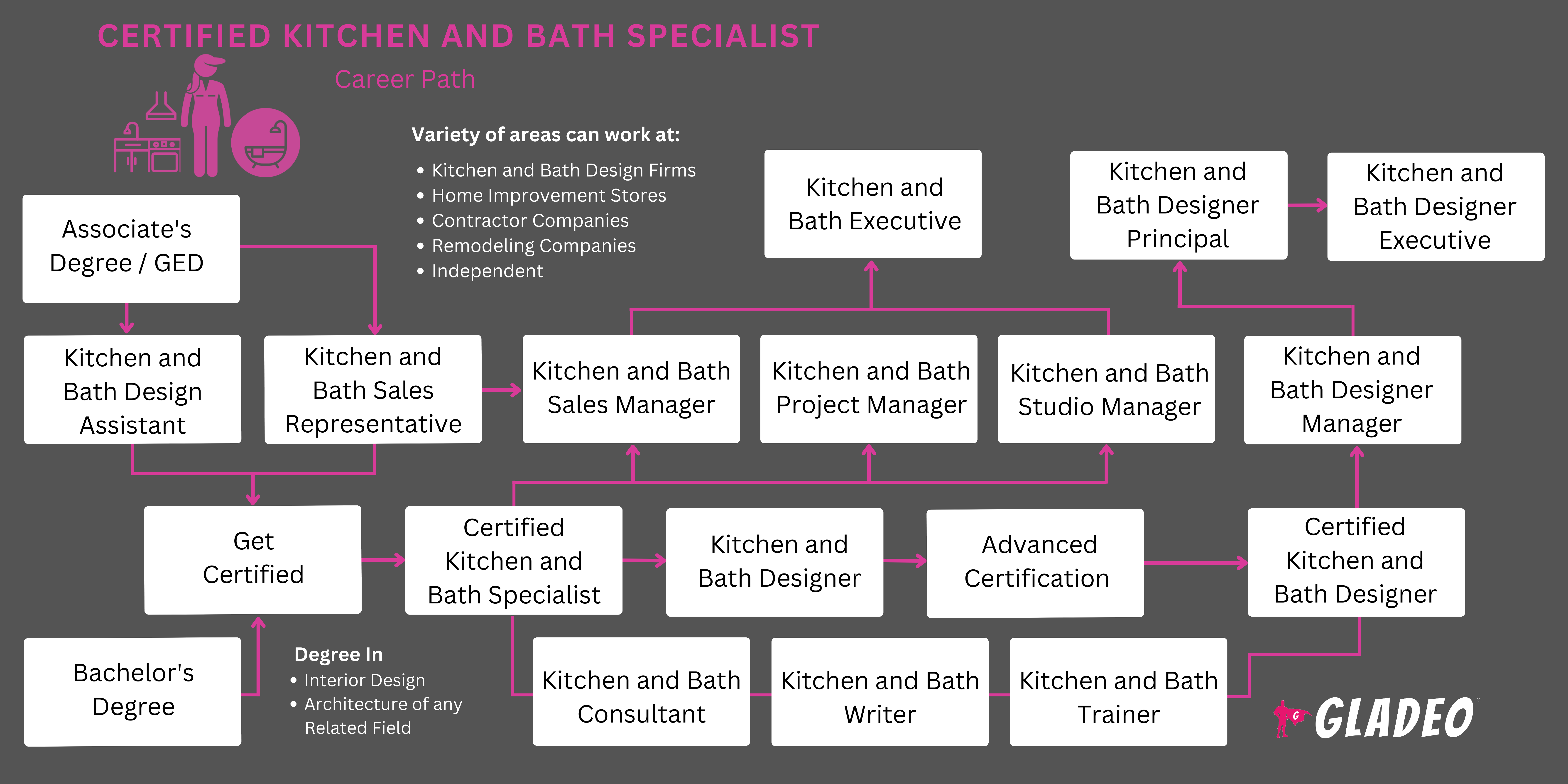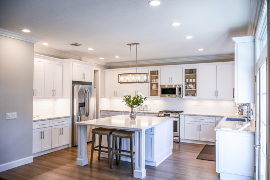Focos de atención
Diseñador de cocinas y baños, Diseñador de cocinas, Diseñador de baños, Diseñador de interiores (con especialización en diseño de cocinas y baños), Diseñador residencial (con especialización en espacios de cocinas y baños), Decorador de interiores (con especialización en interiores de cocinas y baños), Planificador de espacios (específicamente para espacios de cocinas y baños), Consultor de cocinas y baños.
Of all the rooms in a building, the kitchen and bathroom are the most complex because they have plumbing fixtures. They may also have built-in cabinets, tiles, special lighting, and other unique features not found in other rooms. Many homeowners and commercial properties like to put extra effort into their kitchens and bathrooms, so they turn to Certified Kitchen and Bath Designers for their expertise.
These professionals specialize in creating elegant, functional, and efficient spaces that combine elements of interior design with an understanding of kitchen and bath structures. They work closely with contractors and suppliers to design and execute projects that meet the needs, preferences, and budgets of their clients.
Certified Kitchen and Bath Designer duties range from planning electrical and plumbing configurations to selecting materials and fixtures (while adhering to building codes and regulations). Their finished projects can significantly raise a property’s value—which is another reason why so many owners turn to these experts!
- Enhancing the functionality, beauty, and value of homes and other buildings
- The creative challenge of designing rooms that feature plumbing and other unique aspects
- Personal satisfaction from bringing clients’ visions to life
Horario de trabajo
- Certified Kitchen and Bath Designers typically work full-time, with hours that may include evenings and weekends. Self-employed workers may have more flexible schedules.
Tareas típicas
- Meet with clients to go over their needs, preferences, budgets, and timeframes
- Discuss options for color schemes, materials, furnishings, and decorative elements
- Provide an estimate of costs including materials and labor
- Review existing building plans. Inspect the physical spaces (i.e., the kitchens and bathrooms), if possible
- Capture images of the spaces in their current state
- Consider the number of people who will likely use the space
- Sketch or use computer-aided drafting to do some initial design taking into consideration where the walls, cabinets, appliances, lighting, plumbing, fixtures, and electrical outlets are, and whether any of those things will be moved, replaced, etc.
- Use building information modeling software to make 3D visualizations
- Present concepts to clients, solidify design plans, and obtain
approval to proceed with construction, painting, etc. Make requested changes, as needed - Ensure designs comply with building codes and standards
- Select materials, finishes, and appliances. Coordinate with contractors and suppliers
- Monitor project progress and keep an eye on budgets
- Review finished spaces with clients. Speak with contractors if clients have any issues
Responsabilidades adicionales
- Manage business operations, if self-employed
- Market services to potential clients
- Look for projects to bid on, and keep track of going rates
- Continue your education to maintain certification and stay current with trends
- Network with professionals in related fields, such as architecture and construction
Habilidades blandas
- Adaptabilidad
- Analítica
- Atención al detalle
- Creatividad
- Servicio de atención al cliente
- Confiable
- Independiente
- Innovador
- Habilidades interpersonales y de comunicación
- Problem-solving ability
- Realista
- Gestión del tiempo
Habilidades técnicas
- Artistic abilities to conceptualize and visualize aesthetic and functional spaces, incorporating color theory, texture, and lighting design
- Includes hand-drawing skills for initial sketches and an eye for design trends and timeless styles
- Proficiency in design software such as AutoCAD and SketchUp for 3D modeling for drafting detailed floor plans, elevations, and renderings
- Knowledge of construction, plumbing, and electrical systems
- Includes the ability to read and create detailed construction documents
- Understanding of plumbing systems (e.g., water supply and waste lines)
Understanding of electrical systems (e.g., lighting and appliance circuits)
- Ergonomics and space planning for ensuring accessible, safe, and practical layouts
- Includes knowledge of human dimensions, how people interact in environments
- Familiarity with materials and finishes suitable for kitchen and bath environments
- Includes countertops, cabinetry, flooring, wall coverings, and fixtures Understanding durability, maintenance, and aesthetics of materials
- Project management skills (including budgeting, scheduling, problem-solving, and coordination of tradespeople)
- Visualization (may include the use of 3D rendering tools and virtual reality)
- Sustainable design principles and materials to create energy-efficient, environmentally spaces
- Includes knowledge of water-saving fixtures, energy-efficient lighting and appliances, and the use of non-toxic, recyclable, and renewable materials
- Regulatory compliance and knowledge of building codes, standards, and regulations, including Americans with Disabilities Act guidelines for accessible design
- Self-employed/freelance
- Residential design firms
- Kitchen and bath showrooms
- Home improvement stores
- Empresas de construcción
The average cost to remodel a bathroom is $11,500, while a kitchen remodel averages $26,000! That’s a substantial investment for most homeowners, which is why Certified Kitchen and Bath Designers must be on top of their game.
Success depends on finding the right balance between creative design and functional, code-compliant solutions. Designers must navigate client expectations, project challenges, budget constraints, and deadlines. Sometimes this requires negotiation and innovative problem-solving.
They may juggle multiple projects at once, requiring excellent organizational skills and focus. There’s also an expectation to commit to continuous learning as technologies and trends evolve.
When it comes to kitchen and bath design, sustainability and smart home technology are the hottest trends. Clients want more than just the aesthetic appeal of eco-friendly materials; they want efficient appliances and spaces that integrate technology. This includes the adoption of smart faucets that reduce water waste and adaptive lighting systems that conserve energy.
For homeowners who can afford it, there’s a growing emphasis on personalized, customized spaces that reflect individual tastes and lifestyles. In addition, natural materials like wood and stone are making a comeback because of their durability, eco-friendly properties, and timeless visual appeal. Related to this shift is the installation of larger windows and glass doors to invite natural light and outdoor views.
Individuals drawn to this career likely had a keen interest in drawing, home decorating, or interior design. In addition, they may have had natural aptitudes in math and mechanical concepts.
- Certified Kitchen and Bath Designers need a strong mix of education and practical work experience!
- Workers in this field commonly hold an associate's or bachelor’s degree in interior design. Common college course topics may include:
- Teoría del color
- Diseño asistido por ordenador
- History of Interior Design
- Interior Materials and Finishes
- Introduction to Interior Design
- Lighting Design
- Planificación del espacio
- In addition, workers usually need a related credential such as the National Kitchen & Bath Association (NKBA) Certified Kitchen & Bath Designer (CKBD)
- As listed on NKBA’s website, candidates for this certification “must be an NKBA member in good standing and meet specific education and work experience requirements. The four CKBD candidates categories include:
◘ “Allied Professional – NCIDQ Certificate Holder or Registered Architect
◘ “Post-Secondary Education – Master’s, Bachelor’s or Associate’s Degree or Diploma in Interior Design or Architecture.
◘ “Post-Secondary Education – Certificate in Interior Design or Architecture
◘ “Alternative Pathway – No degree, diploma or certificate in Interior Design or Architecture.”
- Note, the length of the Certified Kitchen & Bath Designer course varies based on the student’s prior educational history.
- Those with a degree in interior design or architecture don’t need to take additional NKBA education hours.
- Those with a certificate need to take 30 hours.
- Those with no degree or certificate must take 60 hours.
- Other NKBA certification options include:
- Associate Kitchen and Bath Designer
- Certified Bath Designer
- Certified Kitchen and Bath Installer
- Certified Kitchen Designer
- A college degree isn’t required for every job in this field. Some workers start without a four-year degree if they have enough related work experience.
- The National Kitchen & Bath Association offers a list of affiliated community colleges, technical schools, and universities around the nation. Apart from these, look for an interior design degree program with courses related to kitchen and bath design!
- Seek programs that offer practical experiences, like internships or cooperative education opportunities.
- Consider the affordability of the program, availability of financial aid—and the institution’s connections with industry employers!
- Study art, design, photography, and computer-aided design (CAD) courses in high school to develop a foundation in design principles
- Check to see if your school offers construction-related courses or pre-apprenticeships
- Work part-time in home improvement stores, design showrooms, or with construction firms to gain industry insight
- Volunteer with organizations like Habitat for Humanity
- Pursue internships with design firms specializing in kitchens and baths
- Check out interior design apprenticeships in your area
- Join student chapters of professional organizations like the National Kitchen & Bath Association
- Subscribe to magazines and websites like Kitchen & Bath Design News, Kitchen & Bath Business, or Home & Design
- Go to design and industry expos to learn about trends and technologies
- Join organizations like the National Kitchen & Bath Association to grow your network

- Look for entry-level positions, internships, or apprenticeships to get your foot in the door at design firms, home improvement stores, or kitchen and bath showrooms
- Acude al centro de orientación profesional de tu centro de estudios para que te ayuden a preparar currículos y hacer simulacros de entrevistas.
- Ask the industry professionals in your network about job tips
- Review postings on Indeed, Glassdoor, and other job portals
- Note the keywords in job ads, and incorporate them into your resume where possible, to help it get through applicant tracking system programs! Common keywords might include:
- Architecture
- Computer-aided Design
- Armarios a medida
- Design Process
- Eco-friendly Solutions
- Diseño gráfico
- Innovative Storage Solutions
- Integrated Living Spaces
- Luxury Appliances
- Material Selection
- Minimalist Aesthetics
- Gestión de proyectos
- Smart Home Technology
- Planificación del espacio
- Sustainable Materials
- Universal Design
- Take a look at resume templates for Certified Kitchen and Bath Designers
- Include your design skills, software proficiency, and relevant experience
- Avoid spelling or grammar mistakes. Ask a friend to review before submitting
- Review common Certified Kitchen and Bath Designer interview questions to practice your replies in mock interviews
- Infórmese sobre las tendencias y familiarícese con las tecnologías y la terminología.
- Build an online portfolio showing off your design projects! Include well-lit before and after photos, 3D renderings—or 360 panoramas to really stand out!
- Express your interest in career advancement to your supervisors. Ask their advice on how you can prepare for higher-level positions
- Work on your client’s projects as if it were your own kitchen or bathroom! Give each project your full attention and care
- Keep your skills sharp and current via professional development courses
- Knock out some new certifications through the NKBA or other organizations
- Expand your network to learn about new opportunities and trends
- Tackle challenging projects to showcase your creativity and problem-solving skills
- Dive into a niche area of kitchen and bath design, such as sustainable design or smart home technologies
- Continue to build your portfolio
- Get feedback from your clients and mentors so you can evolve your design approach
- Consider earning a graduate degree to qualify for management positions
- Stay active in professional organizations to build your reputation as an industry leader
- If necessary to advance, consider applying to another company if you see a job opening. Or, if you’re ready, launch your own business!
Páginas web
- American Academy of Healthcare Interior Designers
- Instituto Americano de Arquitectos
- American Society of Interior Designers
- California Council for Interior Design Certification
- Consejo de Acreditación de Diseño de Interiores
- Council for Interior Design Qualification
- Home & Design
- Homestyler
- Houzz
- Asociación Internacional de Diseño de Interiores
- Kitchen & Bath Business
- Kitchen & Bath Design News
- Asociación Nacional de Escuelas de Arte y Diseño
- Asociación Nacional de Cocina y Baño
- USGBC
Libros
- Beautiful Kitchens & Baths Summer 2023, by The Editors of Beautiful Kitchens and Baths
- Dream Kitchens and Baths: Gather In Style, by The Editors of Dream Kitchens and Baths
- Kitchen and Bath Design: A Guide to Planning Basics, by Mary Fisher Knott
Being a Certified Kitchen and Bath Designer can be a lot of fun, but it requires a wide range of both creative and technical skills. If some aspects of this career field sound good, but you want to explore other options, consider the following list of professions requiring similar skill sets:
- Arquitecto
- Architectural and Civil Drafter
- Director de Arte
- Commercial and Industrial Designer
- Artesanía y bellas artes
- Diseñador de moda
- Diseñador floral
- Diseñador gráfico
- Diseñador industrial
- Arquitecto paisajista
- Dibujante mecánico
- Merchandise Displayer and Window Trimmer
- Diseñador de decorados y exposiciones
- VFX Artist
Newsfeed

Trabajos destacados

Cursos y herramientas en línea








